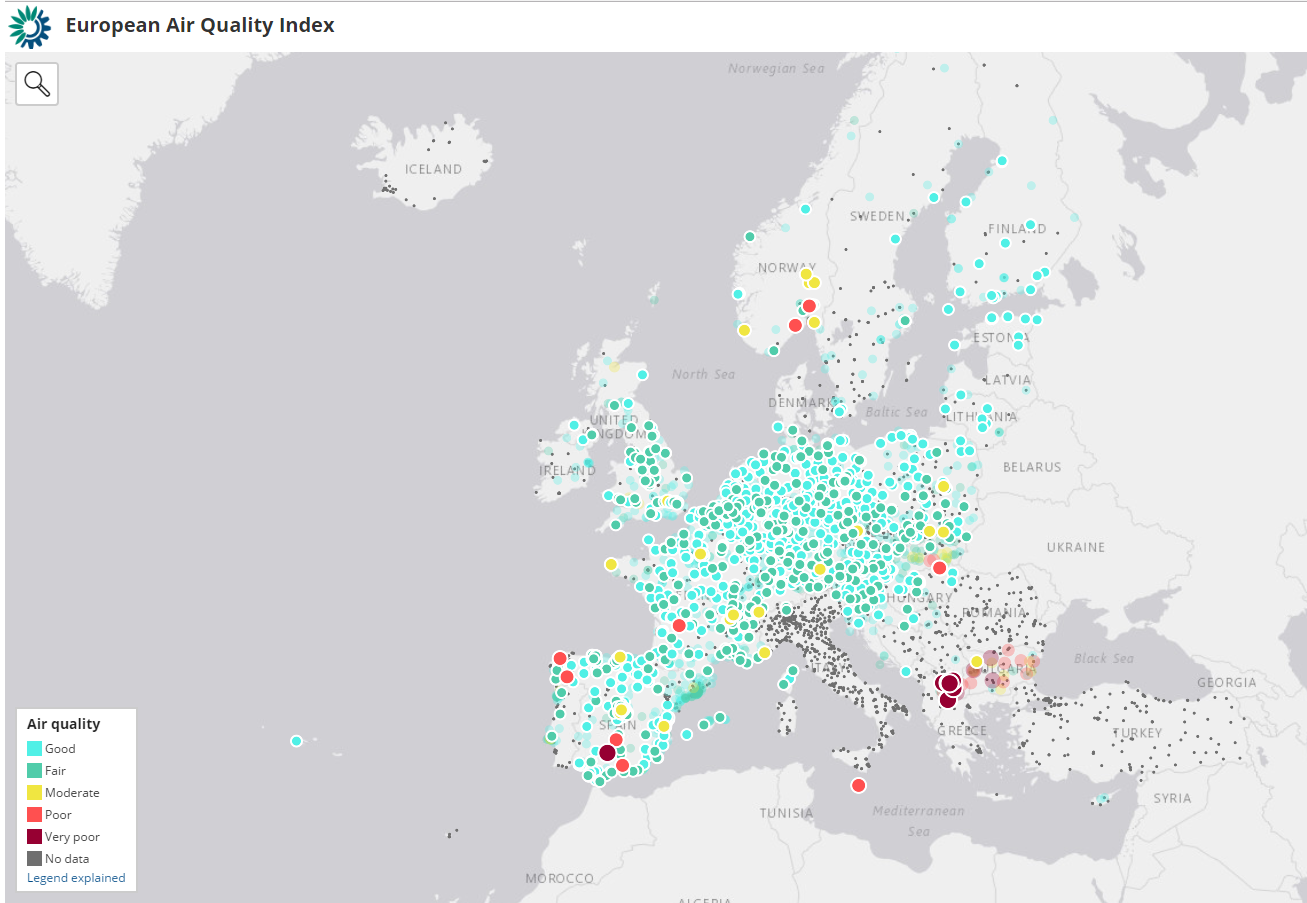Europe’s air quality has improved considerably since the European Union and its Member States introduced policies and measures concerning air quality in the 1970s. Air pollutant emissions from many of the major sources including transport, industry, and power generation are now regulated and are generally declining, but not always to the extent envisaged. High concentrations of air pollution still have significant impacts on Europeans' health, with particulate matter and nitrogen dioxide causing the biggest harm.
The European Environment Agency's latest annual air quality report shows that most people living in Europe's cities are still exposed to levels of air pollution deemed harmful by the World Health Organization. According to the report, fine particulate matter concentrations were responsible for an estimated 428 000 premature deaths in 41 European countries in 2014, of which around 399 000 were in the EU-28.
Poor air quality also has considerable economic impacts, increasing medical costs, reducing workers' productivity, and damaging soil, crops, forests, lakes and rivers. Although air pollution is often associated with pollution peaks and episodes, long-term exposure to lower doses constitutes an even more serious threat to human health and to nature.
Reducing air pollution helps tackle climate change
Carbon dioxide may be the largest driver of global warming and climate change but it is not the only one. Many other gaseous or particulate compounds, known as ‘climate forcers’, have an influence on the amount of solar energy (including heat) the Earth retains.
For example, methane is a very powerful climate forcer as well as an air pollutant linked to agricultural activities, closely linked to livestock production and meat consumption. Particulate matter is another pollutant, impacting both climate change and air quality. Depending upon its composition, it may have a cooling or warming effect on the local and the global climate. For example, black carbon, one of the constituents of fine particulate matter and a result of incomplete burning of fuels, absorbs solar and infrared radiation in the atmosphere and thus has a warming effect.
Measures to cut emissions of short-lived climate forcers such as black carbon, methane, ozone or ozone precursors benefit both human health and the climate. Greenhouse gases and air pollutants share the same emission sources. Therefore there are potential benefits, including cost savings, that can be obtained by limiting emissions of one or the other.
However, in the past certain measures have been promoted to benefit, among others, climate change but which have had unintended negative impacts on air quality. For example, many countries promoted diesel vehicles but which have turned out to emit high levels of air pollutants. Similarly, the promotion of renewable wood burning in some areas of Europe has unfortunately led to high levels of particulate matter in the local air. We must learn from such examples and make sure the consequences of the measures we choose to implement are properly understood and factored in.
The links between climate change and air quality are not limited to common pollutants released into the atmosphere from the same sources. Climate change can also aggravate air pollution problems. In many regions across the world, climate change is expected to affect local weather, including the frequency of heat waves and stagnant air episodes. More sunlight and warmer temperatures might not only prolong the periods of time in which ozone levels are elevated, it may also exacerbate peak ozone concentrations further. This is certainly not good news for parts of Europe, experiencing frequent episodes of excessive ground-level ozone.
Taking coherent action from local to global
Air pollution is not the same everywhere. Different pollutants are released into the atmosphere from a wide range of sources. Road transport, agriculture, power plants, industry and households are the biggest emitters of air pollutants in Europe. Once in the atmosphere, these pollutants can transform into new pollutants and spread. Designing and implementing policies to address this complexity are not easy tasks.
Given the diversity of sources both in terms of geographical distribution and economic activity, action must be taken at different levels from local to international. International conventions can aim to reduce the amount of pollutants released into the atmosphere, but without local action — such as information campaigns, removing highly polluting vehicles from cities or urban zoning decisions — we would fall short of reaping the full benefits of our efforts. This diversity also means that there is no one-size-fits all solution to air pollution. To reduce exposure and subsequent harm further, authorities need to adapt their measures to account for local factors such as sources, demographics, transport infrastructure and local economy.
To enhance the cohesion between actions taken at local, national, European and global level, the European Commission brought together different stakeholders from across Europe at the Clean Air Forum in November. The Forum, held in Paris, not only focused on improving air quality in cities, but also on air pollution from agricultural activities. It also highlighted innovation and business opportunities linked to clean air actions.
Information key to minimise exposure
The European Environment Agency works with its member countries to gather comparable air quality information over time. Based on the data collected, we measure progress, analyse trends and look for links between sources such as road transport and actual measurements of air quality.
When needed, measurements from monitoring stations can be complemented by satellite observations. Under its Copernicus Earth Observation programme, the EU launched in October a new satellite tasked to monitor air pollution, which has already started delivering images. This information is then regularly shared with the public and the policy makers. It is important to note that the Agency deals only with outdoor air quality, and not with the quality of the air we breathe at home or at work, which also has direct impacts on our health.

As part of our efforts to provide the most updated information, we developed together with the European Commission a new online service: the European Air Quality Index. Presented at the Clean Air Forum, the Index provides information on the current air quality situation based on measurements from more than 2 000 air quality monitoring stations across Europe. The Index allows citizens to use an interactive map to check the air quality at station level, based on five key pollutants that harm people's health and the environment: namely particulate matter (both PM2.5 and PM10), ground-level ozone, nitrogen dioxide and sulphur dioxide. This tool allows us to share this information with all Europeans interested in addressing air pollution. We can all check air quality where we are and take precautionary measures to reduce our exposure to pollution.
Information is certainly essential to address air pollution and to reduce its harmful impacts. However, to improve air quality and to meet the EU’s longer-term low carbon goals, we need to address emissions from all economic sectors and systems like mobility, energy or food, and understand production and consumption patterns that generate these emissions. This is the only way forward. The EEA stands ready, as a knowledge partner, to help achieve these long term goals.

Hans Bruyninckx
EEA Executive Director
The editorial published in EEA Newsletter, Issue 2017/4, 15 December 2017


Document Actions
Share with others